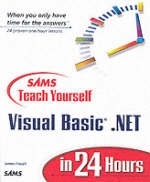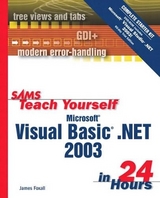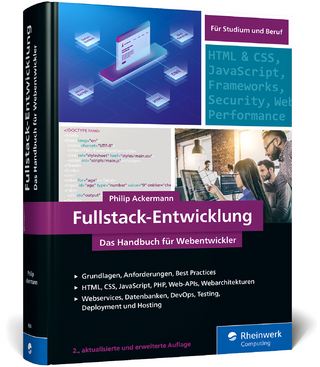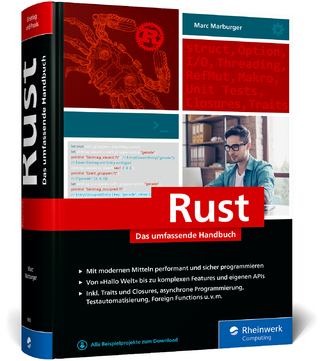
Sams Teach Yourself Visual Basic.NET in 24 Hours
Sams Publishing (Verlag)
978-0-672-32080-4 (ISBN)
- Titel erscheint in neuer Auflage
- Artikel merken
Teach Yourself Visual Basic.NET in 24 Hours provides readers with 24 structured lessons with step-by-step guidance to real-world tasks. Each chapter also contains exercises that reinforce the lessons learned in each chapter. Tips, Notes, and Cautions provide additional advice from the authors on how to get up-to-speed and programming quickly with Visual Basic.NET.
James Foxall is vice president of Tigerpaw Software, Inc. and is a Microsoft Certified Solution Provider (MCSP) specializing in commercial database applications. James is responsible for management of all Windows application development at Tigerpaw, and he is an authority on application interface and behavior standards of applications for the Microsoft Windows and Office environments. James, a MCSD, has written more than 100,000 lines of commercial production Visual Basic code in both single-programmer and multiple-programmer environments. James is the author of several books on Visual Basic, including the a definitive work on standards, entitled Practical Standards for Microsoft Visual Basic (Microsoft Press), MCSD in a Nutshell: The Visual Basic Exams (O'Reilly), Discover Visual Basic, Access 97 Secrets (Hungry Minds), Access for Windows 95 Secrets (Hungry Minds), and the Access 97 Bible Gold Edition (Hungry Minds). He also contributes to Visual Basic Programmer's Journal and Access/Office/VBA Advisor magazine, and he is an international speaker on Visual Basic and Access. In addition to speaking and writing, James has taught Visual Basic at the college level and has been featured on numerous television news shows, in trade publications, and in newspaper articles for his technology expertise.
(NOTE: Each chapter concludes with a Summary, Q&A, and Workshop Section.)
Introduction.
I. THE VISUAL BASIC ENVIRONMENT.
Hour 1 A Visual Basic .NET Programming .NET Programming Tour.
Starting Visual Basic .NET. Creating a New Project. Understanding the Visual Basic Environment. Changing the Characteristics of Objects. Naming Objects. Setting the Text Property of the Form. Giving the Form an Icon. Changing the Size of the Form. Adding Controls to a Form. Designing an Interface. Adding an Invisible Control to a Form. Coding an Interface. Running a Project.
Hour 2 Navigating Visual Basic.
Using the visual Studio .NET Start Page. Navigating and Customizing the Visual Basic Environment. Adding Controls to a Form Using the Toolbox. Setting Object Properties Using the Properties Window. Managing Projects. Managing Project Files with the Solution Explorer. Getting Help.
Hour 3 Understanding Objects and Collections.
Understanding Objects. Understanding Properties. Understanding Methods. Building an Object Example Project. Understanding Collections. Using the Object Browser.
Hour 4 Understanding Events.
Understanding Event-Driven Programming. Building an Event Example Project. Dealing with Orphaned Events.
II. BUILDING A USER INTERFACE.
Hour 5 Building Forms-Part I.
Changing the Name of a Form. Changing the Appearance of a Form. Showing and Hiding Forms.
Hour 6 Building Forms-Part II.
Working with Controls. Creating TopMost Windows. Creating Transparent Forms. Creating Scrollable Forms. Creating MDI Forms. Setting the Startup Object.
Hour 7 Working with the Traditional Controls.
Displaying Static Text with the Label Control. Allowing Users to Enter Text Using a Text Box. Creating Buttons. Creating Containers and Groups of Option Buttons. Displaying a List with the List Box. Creating Drop-Down Lists Using the Combo Box.
Hour 8 Advanced Controls.
Creating Timers. Creating Tabbed Dialog Boxes. Storing Pictures in an Image List. Building Enhanced Lists Using the List View. Creating Hierarchical Lists with the Tree View.
Hour 9 Adding Menus and Toolbars to Forms.
Building Menus. Programming Menus. Using the Toolbar Control. Creating a Status Bar.
Hour 10 Drawing and Printing.
Understanding the Graphics Object. Working with Pens. Using System Colors. Working with Rectangles. Drawing Shapes. Drawing Text. Persisting Graphics on a Form. Build a Graphics Project Example.
III. MAKING THINGS HAPPEN-PROGRAMMING!
Hour 11 Creating and Calling Code Procedures.
Creating Visual Basic Code Modules. Writing Code Procedures. Creating the User Interface of Your Project. Calling Code Procedures. Exiting Procedures. Avoiding Recursive Procedures. Using Sub Main. Working with Tasks.
Hour 12 Using Constants, Data Types, Variables, and Arrays.
Understanding Data Types. Defining and Using Constants. Dimensioning and Referencing Variables. Determining Scope. Declaring Variables of Static Scope. Naming Conventions.
Hour 13 Performing Arithmetic, String Manipulation, and Date/Time Adjustments.
Performing Basic Arithmetic. Comparing Equalities. Understanding Boolean Logic. Working with Dates and Times.
Hour 14 Making Decisions in Visual Basic Code.
Making Decisions Using If...Then. Evaluating an Expression for Multiple Values Using Select Case. Branching Within a Procedure Using GOTO.
Hour 15 Looping for Efficiency.
Looping a Specific Number of Times Using For...Next. Using Do...Loop to Loop an Indeterminate Number of Times.
Hour 16 Debugging Your Code.
Adding Comments to Your Code. Identifying the Two Basic Types of Errors. Using Visual Basic's Debugging Tools. Writing an Error Handler Using Try...Catch...Finally.
Hour 17 Designing Objects Using Classes.
Understanding Classes. Instantiating Objects from Classes.
Hour 18 Interacting.
Displaying Messages Using the MsgBox() Function. Creating Custom Dialog Boxes. Using InputBox () to Get Information from a User. Interacting with the Keyboard. Using the Common Mouse Events.
IV. WORKING WITH DATA.
Hour 19 Performing File Operations.
Using the Open File Dialog and Save File Dialog Controls. Manipulating Files with the File Object. Manipulating Directories with the Directory Objects.
Hour 20 Controlling Other Applications Using Automation.
Creating a Reference to an Automation Library. Creating an Instance of an Automation Server. Manipulating the Server.
Hour 21 Working with a Database.
Introduction to ADO and ADO.NET. Creating a Reference to ADO. Connecting to a Database. Manipulating Data. Conclusion.
V. DEPLOYING SOLUTIONS AND BEYOND.
Hour 22 Deploying an Application.
Creating a Custom Setup Program. Running a Custom Setup Program. Uninstalling an Application You've Distributed.
Hour 23 Introduction to Web Development.
XML. SOAP. ASP.NET. Web Forms. XML Web Services.
Hour 24 The 10,000-Foot View.
The .NET Framework. Common Language Runtime (CLR). Microsoft Intermediate Language. Namespaces. Common Type System. Garbage Collection.
| Erscheint lt. Verlag | 27.11.2001 |
|---|---|
| Verlagsort | Indianapolis |
| Sprache | englisch |
| Maße | 187 x 230 mm |
| Gewicht | 879 g |
| Themenwelt | Mathematik / Informatik ► Informatik ► Programmiersprachen / -werkzeuge |
| ISBN-10 | 0-672-32080-0 / 0672320800 |
| ISBN-13 | 978-0-672-32080-4 / 9780672320804 |
| Zustand | Neuware |
| Haben Sie eine Frage zum Produkt? |
aus dem Bereich



